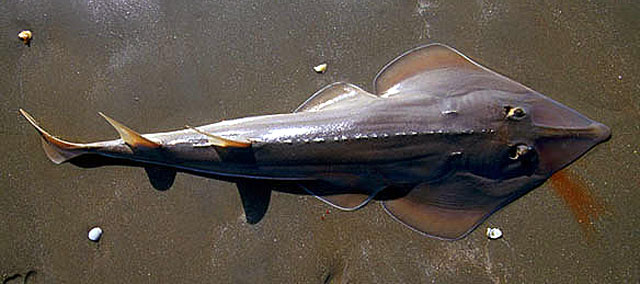| Rhinobatidae (Guitarfishes) |
| 185 cm TL (male/unsexed); max.weight: 27 kg |
|
demersal; brackish; marine; depth range 0 - 100 m |
| Eastern Atlantic: southern Bay of Biscay to Angola, including Mediterranean Sea. |
|
Dorsal spines (total): 0-0; Anal spines: 0-0; Anal soft rays: 0-0. Rostral ridges widely separated over their entire length; anterior nasal lobe reaching to level of inner corner of nostril, posterior nasal flap wide; spiracle with two moderately developed folds, the outer one more prominent; thorns relatively small, present around inner margin of orbits, between spiracles, on shoulders, and along midline of disc and tail; Upper surface khaki-brown, underside white (Ref. 6675). |
| Inhabits sandy and muddy bottoms, from the intertidal zone to about 100 m. Sometimes near rocky reefs (Ref. 12951). Slow swimming over bottom or partially buried. Feeds on benthic invertebrates, mainly crustaceans and small fishes. Males mature at ca. 56 cm TL, females at ca. 64 cm TL; born at ca. 25 cm TL (Ref. 114953). Ovoviviparous, one or two litters per year with 4-10 embryos. |
|
Critically Endangered (CR); Date assessed: 04 August 2020 (A2bd) Ref. (130435)
|
| harmless |
Source and more info: www.fishbase.org. For personal, classroom, and other internal use only. Not for publication.
